‘Behemoth’ is a word which springs to mind or, perhaps more nautically, ‘leviathan’.

Spectacular Waimarama Beach, 32km southeast of Hastings, is much loved by residents, holidaymakers, surfers and hordes of summer visitors. With big ocean swells and exposed to strong winds, it’s a challenging place to go boating, but those who brave launching through the surf are rewarded with excellent fishing and diving.
One such person is Robert Griffiths, a Hawke’s Bay orchardist and jeweller who has boated out of Waimarama for years. Robert’s latest boat, Memories II, a custom 6.5m Senator Typhoon with waterjet propulsion, is built to operate in this challenging environment, as well on Lake Taupo fishing for trout, which could include camping and overnight expeditions.
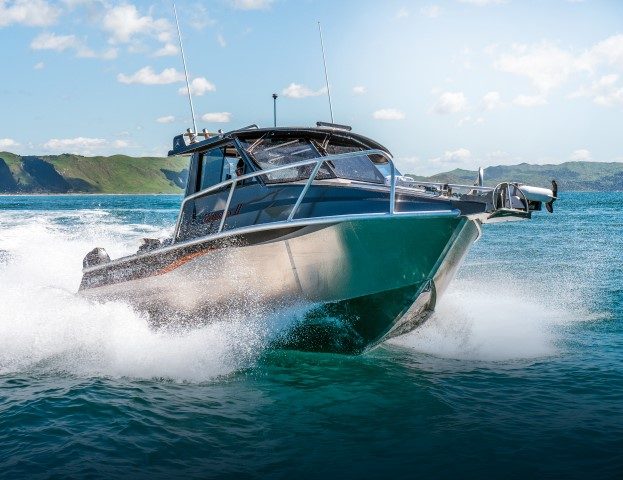
When it became clear just how much Robert wanted to pack into his new vessel, the team at Senator Boats tried to talk him into a larger Typhoon or a Senator pontoon model. Typhoon models share a similar hull profile to the company’s pontoon boats but offer more deck space and higher sides, which is what Robert was after. He was adamant however, that 6.5m was the maximum length – any longer (and heavier) would compromise the boat’s agility in the surf. Memories II has a standard Typhoon 6.5m hull and cabin, with numerous modifications to accommodate Robert’s specific requirements.
During the build phase, Robert, always accompanied by a box of apples, made weekly visits to Senator Boats’ Napier facility to check on progress and work through his ideas with factory manager Roger Young and boatbuilder Paul Steele. One tradesman is responsible for building each Senator boat from start to finish, so Paul was charged with turning Robert’s ideas – often interpreted and refined by Roger – into reality.
Third time lucky
On our third attempt at this story, Waimarama Beach turned on perfect conditions, with bright sunshine, little wind and low surf. After two prior cancellations due to unworkable surf, seeing the low waves rolling onto the beach was a relief, but I got the impression the local team was a little disappointed not to be able to show off the Typhoon in more typically challenging conditions.
Experienced local boaters still work the beach when the waves are high enough to share with Waimarana’s surfing fraternity, but even on a nice day, I could see how this would be a tricky spot in any sort of swell.
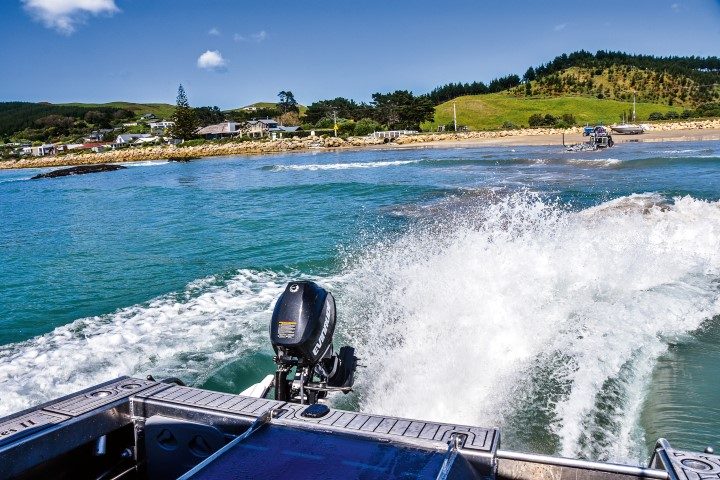
Helping us with our beach launching, and kindly supplying his own boat to serve as a photographic platform, Monty backed Memories II down the beach and into the low surf. The Senator is carried on a top quality, dual-axle DMW Premier trailer with override brakes on both axles. For beach work, Robert uses a veteran David Brown tractor. Like Monty’s mint condition blue Ford, Robert’s David Brown is immaculately restored and maintained.
A tractor is advisable to safely beach-launch at this location. Boats are slipped into the sea close alongside Kuku Rocks, a low reef that blocks some of the power of the incoming waves. The usual drill is to slip the boat off the trailer in time with an incoming wave, the crew standing in the water to spin it bow-on to the surf. Picking a suitable set, the skipper then loads the crew over the sides, guns the engine and punches out through the breakers. Anyone too slow getting on is left behind.

But for us the sea was flat enough that no-one needed to get wet: as soon as an incoming wave provided sufficient water depth, Robert started the engine with us aboard, backed the boat off the trailer, spun it in its own length and powered out to sea. With 400hp of V8 power and torque transferred to the water via a HamiltonJet 212 jet unit, the response was instant.
HamiltonJet
A jet can deliver power in very shallow water, and unlike an outboard, which has to be tilted up to operate when it’s shallow, the jet’s drive nozzle is above the keel, so there’s little chance of contacting the bottom and no danger if it does. An outboard risks driving its propeller into the bottom as the boat punches through the surf, stalling the motor.
We shot out past the last line of low rollers in seconds, the single-stage jet leaving a trail of roiled sand in the shallows. We barely shipped a drop of water, but the Typhoon 650 is a hardtop model with twin windscreen wipers, a self-draining cockpit and heaps of handholds to grip when tackling the breakers. In addition, the boat has bilge pumps in sumps either side of the cockpit and another inside the engine box, all on float switches.
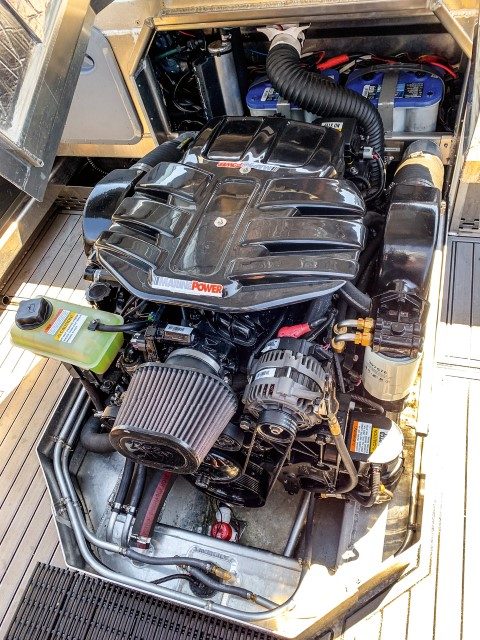 The six-litre V8 is a compact unit, but the engine box still takes up a good part of the cockpit. Engine start and house batteries are located at the rear of the engine compartment, off the floor and well protected. The top of the close-fitting engine box is covered with a thin layer on non-slip SeaDek, as is the hardtop roof, with a lip around the outside to stop small objects sliding off.
The six-litre V8 is a compact unit, but the engine box still takes up a good part of the cockpit. Engine start and house batteries are located at the rear of the engine compartment, off the floor and well protected. The top of the close-fitting engine box is covered with a thin layer on non-slip SeaDek, as is the hardtop roof, with a lip around the outside to stop small objects sliding off.
It’s a useful work table, says Robert – somewhere to bait cray pots, rig fishing gear or make coffee. The bait board slots into a customretainer at the front of the engine box – he doesn’t like anything loose inside the boat.
Despite the engine box, the cockpit has plenty of fishing room, especially with the rear-facing seats folded in the down position. Hella Marine LED lighting is used throughout, including cockpit and foredeck floodlights.
Four through-coaming rod holders per side and an eight-position rocket launcher (incorporating Robert’s custom spoiler) take care of fishing duties and rod storage. A pot hauler on the starboard side – there are hundreds of cray pots around Bare Island just offshore – can be removed when not required.
There’s good access to the transom either side of the engine box and the custom transom door on the port side opens onto the wide swim platform with provision for a large fish bin. There’s no cage, which would only complicate beach launching.
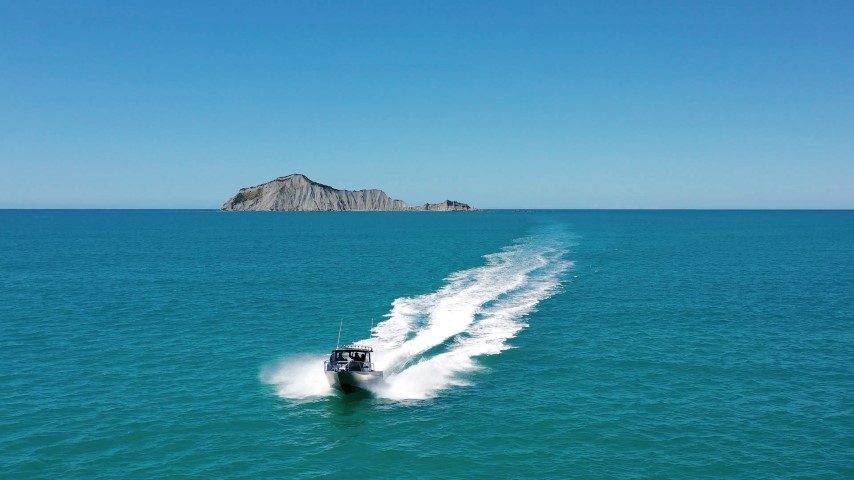
In trout fishing mode, which for Robert means harling (trolling a fly or lure behind the boat in relatively shallow water), he uses a 9.8hp Evinrude four-stroke outboard. With separate controls inside the hardtop, it is steered using a wireless remote control on a lanyard from the comfort of the hardtop. Robert came up with an idea for three extension rod holders to angle his harling rods away from the boat to avoid tangled lines, which Paul fabricated for him.
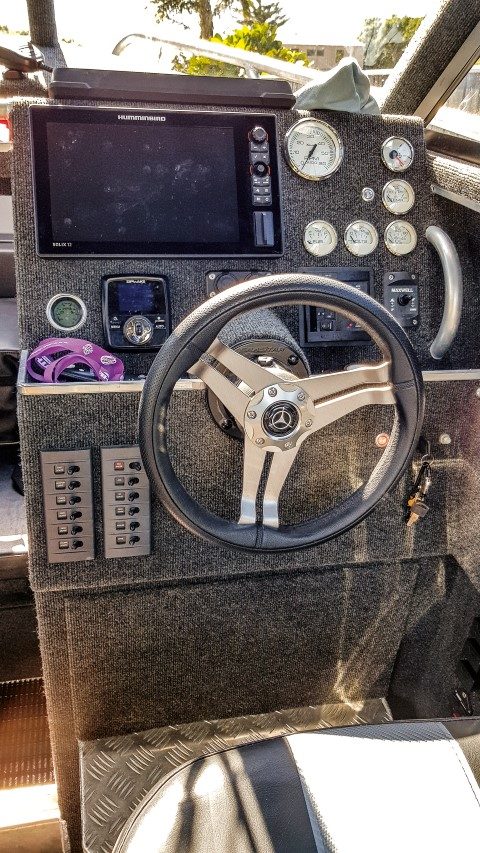 This boat also has a trolling motor on the bow, a 36-volt, 72-inch, GPS-equipped Minn-Kota Rip Tide electric, deployed, stowed and controlled from the Humminbird MFD or the wireless remote control. Three deep-cycle batteries, two under the floor in front of the seats and one inside the forecabin, provide the power and charging ports are located beside the helm console. The electric trolling motor is used to hold the boat in place over a reef, shipwreck or school of fish.
This boat also has a trolling motor on the bow, a 36-volt, 72-inch, GPS-equipped Minn-Kota Rip Tide electric, deployed, stowed and controlled from the Humminbird MFD or the wireless remote control. Three deep-cycle batteries, two under the floor in front of the seats and one inside the forecabin, provide the power and charging ports are located beside the helm console. The electric trolling motor is used to hold the boat in place over a reef, shipwreck or school of fish.
Smart looking, heavy-duty SeaDek is used on Memories II’s cockpit floor, coamings, foredeck and swim platform, embossed with the boat’s name, Senator branding and logos. It feels good under foot, absorbing shocks, and is neither too warm nor too cold. Senator uses vinyl rather than paint – Memories II is wrapped in the colour of Robert’s Porsche SUV.
The hardtop, cockpit and forward cabin are lined with marine carpet, colour-matched to the SeaDek. The overall effect is suitably plush, but practical too, especially for winter boating. Adjustable reading lights are a nice touch.
Somewhere to sleep
Storage is something this boat has in spades, from copious shelving, including tandem side shelves, elasticated net bags for odds and ends, pockets and bins, an underfloor locker and space under the squabs in the cabin. There is no provision for cooking onboard, or freshwater, but the v-berths in the forward cabin are long enough to sleep on, thanks to bunk extensions. Sections of the bulkhead, padded on the inside, fold out to accommodate the sleeper’s lower legs.
A chemical toilet in a separate padded box is strapped to the forward bulkhead. It can be used in place between the v-berths or moved to the cockpit, so cabin occupants don’t have to sleep with it. A sliding, lockable door affords privacy and security, but Senator came up with a clever sliding panel in the door that allows Robert to use the bunk extension with the cabin door open.
Power and performance
As you’d expect, performance from the big V8 is impressive. It’s loud though, especially the induction noise from the engine box air intakes. Top speed is over 30 knots, but the rig is reasonably fuel efficient at more usual speeds. Robert was pleasantly surprised by its modest consumption during a recent weekend at Taupo, which involved a fair amount of running around. Memories II carries 190 litres of fuel under the floor.
Carrying its beam well forward, the Typhoon 650 is a large volume vessel, but there was enough wind chop offshore to demonstrate that it is both dry and soft riding. The entry is sharp, but the deadrise at the transom is modest, so the boat planes easily.
The Typhoon handles like a jet boat should, making high speed jetboat turns and spinning in its own length, in forward or reverse. It is lots of fun to throw around and the reason for all the handrails, including one for the skipper, becomes clear when Robert swings on the wheel!
Senator has cleverly modified an outboard motor throttle lever to work with the jet. Push it forward for throttle (there’s no pulling it back because reverse is achieved by dropping the bucket) and control the bucket using the trim button on the side of the lever. Toggle it all the way down for reverse and all the way up for forward. Neutral is somewhere in the middle, marked with felt pen on the standard outboard trim gauge onthe dash, which has been co-opted to show the bucket position.

Zipwake automatic interceptor trim tabs control pitch and roll. They are a welcome addition since this jet unit is not trimmable. Electronics include a Humminbird Solix 12 MFD, chosen because it interfaces seamlessly with the Minn Kota electric trolling motor. The electric can be controlled from the touch screen. The VHF is easily accessible behind the bulkhead grab rail, there’s a Pioneer stereo head unit under the ceiling and lots of strategically positioned USB/12V outlets.
Hit the beach
We were told returning to the beach can be just as hair-raising as leaving it, but on such a flat day our approach was straight forward. However, the tide was lower than ideal, so Robert had to cut in very close to Kuku Rocks to find enough water, before running the boat up onto the sand. Monty was waiting with the tractor and getting the boat out was quick and efficient, the hydraulic winch making short work of winching it onto the trailer.
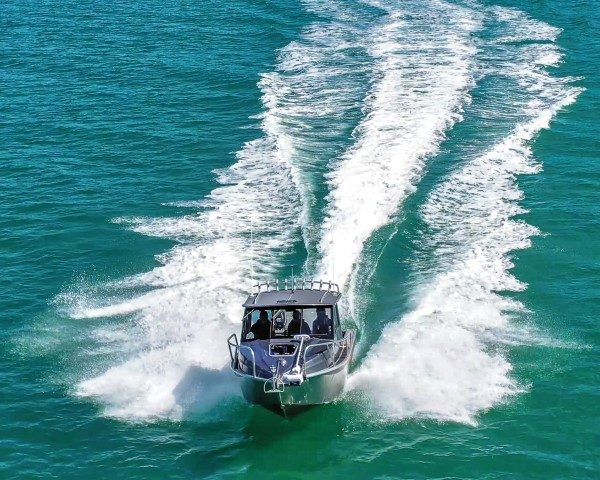
Mission accomplished
Memories II has clearly more than fulfilled Robert’s brief. He loves the boat and is full of praise for the team at Senator Boats – and Hawkes Bay Marine, which did the fit-out.
As we left Waimarama the wind and sea were picking up as Monty prepared to launch his boat for a second time to check his pots. Robert looked tempted, but with his crew headed for the airport, it wasn’t an option this time. Maybe next week …/>
‘Behemoth’ is a word which springs to mind or, perhaps more nautically, ‘leviathan’.
White Pointer has earned the respect of discerning customers in New Zealand and Australia, attracting a loyal and ever growing following for its high-quality, rugged and totally dependable aluminium trailer boats.
The hardtop SP635 shares the same underpinnings as the popular SF 635 which was a completely new model back in 2020.
The pride and joy of a multi-generational family, Bliss resides on a pier that’s home to a couple of other Elite motor launches – Sandspit Marina is a hot-spot for the Bill Upfold-designed vessels, with several calling this small marina home.